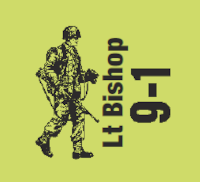
A friend asked me to look at this scenario and discuss how I would set it up as the defender. I emphasized my article on Fortifications in ASL and Defenses is ASL and asked him to see if those helped. He reached back and noted they were great for a generalization, but as a means for practical application, they could use some examples.
While considering this, it occurred to me I have not yet written here on this blog, an article on defending since finalizing my opus Planning in ASL. I have written an article for the forthcoming Horizon magazine from Hazardous Movement which will appear soon.
So, for the first time on this blog, I will refer to defensive patterns from my Defenses is ASL article, as well as my ASL Tactical Maxims, to analyze Bounding Fire’s Training Day from the Defenders perspective. Any defensive patterns noted will be in bold italic text. If you are unfamiliar with these terms, I encourage you to have a read of those earlier articles.
Without further ado.
Maxim 1: Victory Conditions
The Victory Conditions (VC) are pretty simple in this scenario: capture building Q4 or Rubble the whole thing. If you are familiar with my Maxims, you should also be aware it is not enough to just know the VC. You must also know HOW to fulfill the VC. While capture should be very familiar to my readers by now, what about reducing the building to Rubble?
Per B24.11, any HE attack >= 70mm might cause rubble. First, the IFT DR against a Location must be an Original KIA to cause Rubble. Then, on a subsequent dr, the Attacker must roll < the KIA number achieved on the Original IFT DR. There are some additional implications for Area Target Type and OBA. With 150 mm OBA, it is possible to Rubble the whole of building Q4 but it is not likely. To even see all the building, the OBA observer would need to get to level 3 to even see the whole building.
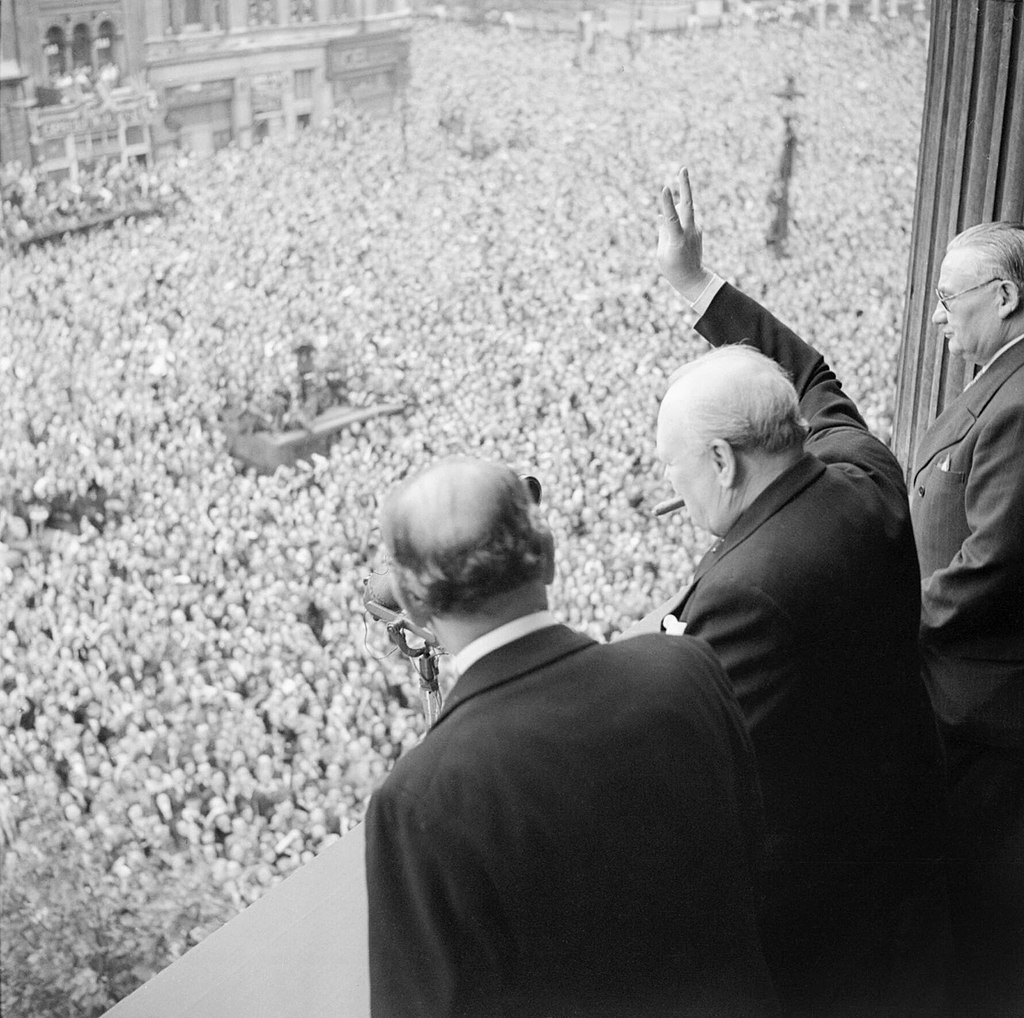
The Germans also receive one ‘39DB with a 150mm bomb. This too, can create Rubble but it would take a series of very fortunate rolls to Rubble all of Q4 this way.
The Germans also have Demo Charges (DC) in their OB. These could also potentially be used to create Rubble, but this might be a mistake. Per SSR, the whole of Building Q4 is Fortified. While occupied by an unpinned, full squad equivalent or more, the Germans cannot enter the Location unless they do so via a Breach. Given the building has a Cellar, Ground floor, and first floor in every hex, there are 24 Locations to take (16 Locations to Rubble if you think you can do that). Using the DC’s to breach is almost a must. AFVs can also create beaches if they make it to the hilltop.
Maxim 2: Terrain
A Deep Stream runs east to west across most of the board. In addition, the added overlays create opportunities for a Choke Point Pattern to be applied. The stream will slow Infantry crossing as it is 4 MF’s and automatic CX to enter the Deep Stream. The German setup area includes some hexes across this water feature, but it is small. As the Defender, I will seek to destroy anything setting up on this side of the stream. The stream itself can also serve as a Linear Defense Pattern.
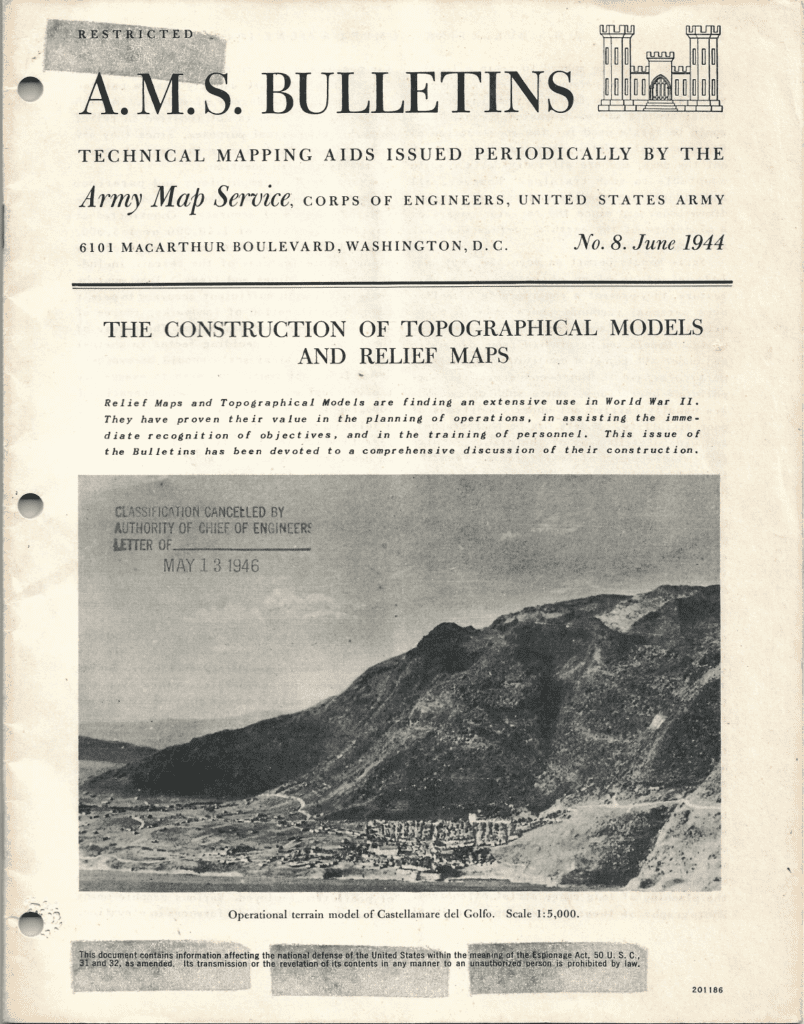
Two Elevated Roads provide passage over the stream for German vehicles and are also excellent opportunities for a Choke Point Pattern. One point worth noting is vehicles may leave the Elevated Road across on non-Road hexside as if leaving a level 1 hill hex. The Defender must protect against vehicles exiting the L5 – Q6 road segment. Such quick access to our defensive depth would be hard to overcome.
Since the Pole sets up as if the Germans are entering from off board, all the Polish Fortifications set up HIP and remain HIP until a Good Order German unit gains LOS and is <= 16 hexes from the Fortification. Even once placed on board, the contents of a Pillbox would remain hidden until a unit inside the Pillbox fires or places Smoke. We must use this Hidden status to our advantage, to further restrict the German’s ability to move. Remember, Fortifications attack maneuverability and our aim is to run out the clock.
Building Q4 will form the basis of the Alamo Defense Pattern. As the defender, we have to be sure we do not give the Attacker a highway into our Alamo. SSR 2 states all Trenches connect to the Cellar Locations in Q4. Such connections are a two-edged sword. They allow a covered avenue for falling back into the Alamo but also provide an entrance into a Location with no Breach. As the Defender, we have to guard against easy entry into Q4. Still, the Trenches will facilitate a Fighting Withdrawal Pattern if placed correctly.
Influence On Infantry Movement

The Deep Stream will slow down Infantry crossing through the Stream. Units which enter the Stream are CX, further limiting the movement of Infantry on the next turn as they will not be able to CX then.
The Poles also have Wire and A-P mines in their arsenal which will further restrict Infantry movement. As the Defender, you must use these assets to create an Area Defense Pattern to push the attacking Infantry into killing zones. The Poles must also cover these Fortifications with fire to make them effective.
There are several Woods hexes which create “dead zones” for Polish fire from the hilltop. The Poles must give special consideration to these to ensure they do not become a highway into the defense.
Remember the VC. Only Infantry can take control of Building Locations. The Polish must focus on eliminating and hampering German Infantry. Eliminating/Breaking the German OBA observer is a priority, followed closely by eliminating Flamethrower toting units.
For the final assault on the Q4 building, the area around BFP-K M4/V4 is the nearest Rally terrain for the attacker. As the Defender, denying this to the Attacker for as long as possible will make it particularly hard to attack into the VC building.
Influence On Vehicular Movement
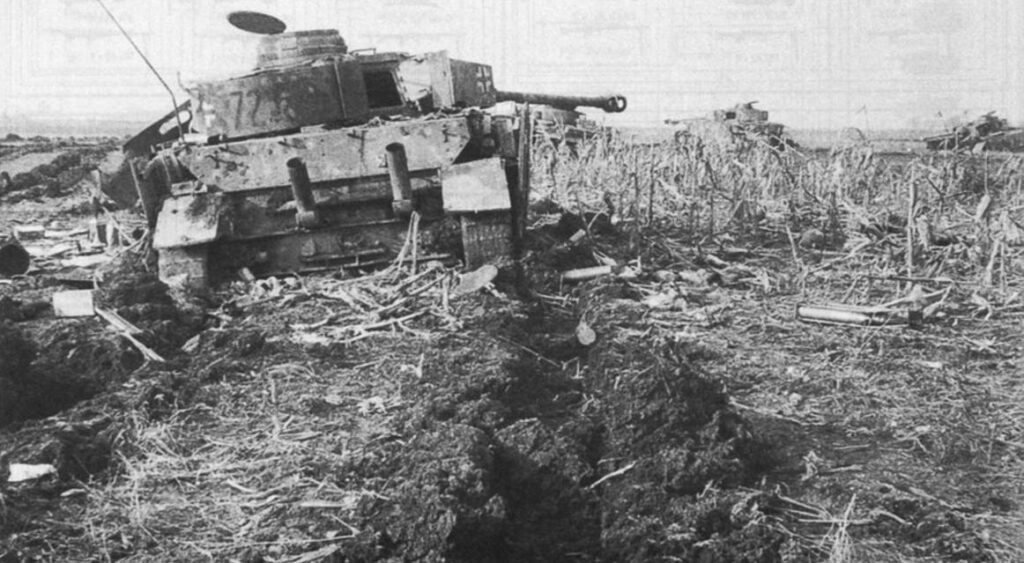
Several Locations around the board are Marsh hexes. Marsh hexes prohibit vehicular movement. Vehicular movement through a Location Adjacent to a Marsh hex is subject to a Bog check. Nearly all German vehicles have Low Ground Pressure, meaning they will only Bog on an Original Bog Check DR 12. This risk is further mitigated by Armor Leaders which can apply their Leadership DRM to the Bog Removal DR.
The Deep Stream does not slow a vehicle down, but it creates a Bog check when leaving the Stream to higher ground. This also adds a +1 DRM to the Bog Check DR. Again, not a significant risk, but not one that can be ignored either.
The Poles also have 10 A-T Ditches which can shut down AFV movement. As this is a BFP scenario, keep in mind the BFP HBR which prohibits vehicular bypass of an A-T Ditch hexside. The Poles also have 12 factors of A-T mines, 48 factors of A-P mines, and Wire, all of which can slow down vehicular movement.
Visualizing The Terrain’s Influence On The Battle
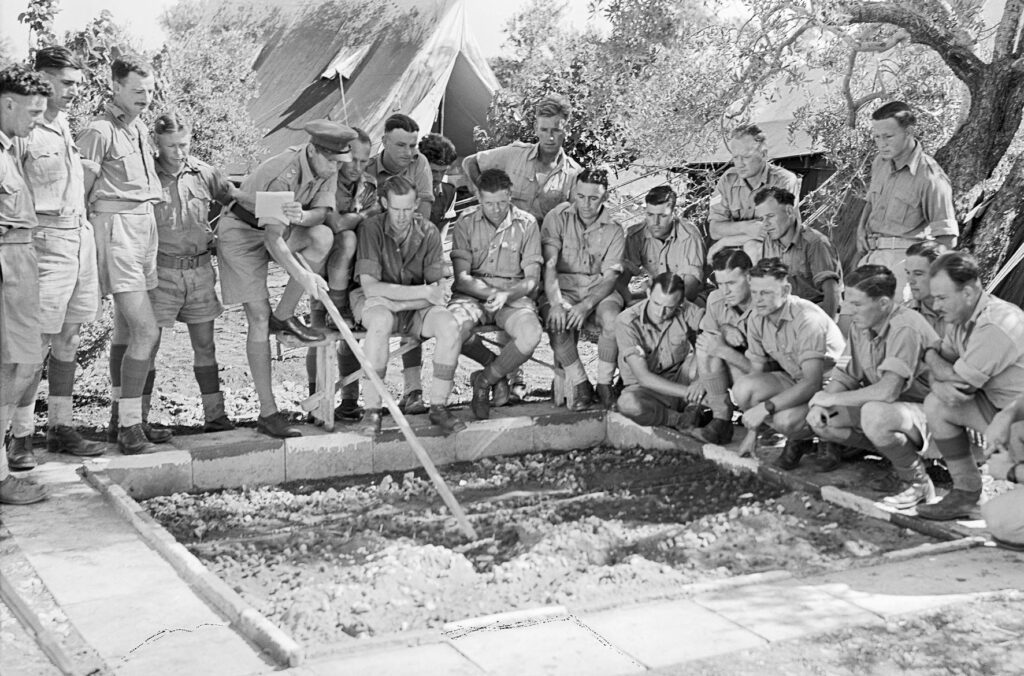
With all the choke points and Fortifications, the Poles should be able to dictate the flow of the battle. This should allow the Poles to get the most out of their assets by forcing the attacker into killing zones throughout the map. The PzII Bridgelayers are a potential “get out of jail free” card for the attackers so focusing on them is justified.
As the Defender, look to take a lot of -1 and -2 shots and leave a wall of residual. The German OBA has to be contended with, but usage of concealment counters and blind hexes should allow you to limit the impact. Once LOS exists to the radio’s Location, putting fire on this leader is important. Smoke in the endgame can allow the Germans to close on the Q4 defenders and CC does not favor the Poles.
Maxim 3: Time
The Germans have 9 turns to cross the board and Capture/Reduce to Rubble building Q4. The Germans can set up on-board or enter on turn 1. As the Poles, I expect the Germans to set everything up on board. This allows them to gain one turn of movement getting forward.
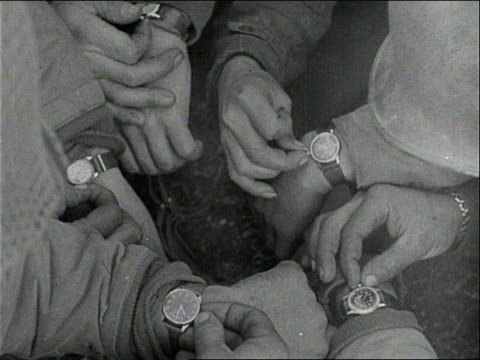
Given that Q4 effectively has 24 Locations spread across three levels, Capturing this building will take at least 3 turns. As the Poles, I plan to have stuffed this building to the gills with Infantry and Guns. This will make the Open Ground on the hilltop into a killing field. This should add at least one more turn to close on the building.
Given the difficulty once the Germans reach the hilltop, this means the Germans have 5 turns or fewer to cross the board to get into position to take the hilltop. Our aim as the defender is to make the Germans pay for every inch of ground he gains. While enemy destruction is a satisfactory result, enemy disruption is our goal. Running out the clock is enough to win this scenario as the Defender.
Maxim 4: Order Of Battle
The Poles

Recall, the Poles set up as if the Germans enter from off board. This means all Fortifications will initially set up HIP. Also, all Guns and MMG/Cupolas can use Bore Sighting. This should come as a nasty surprise for the Germans should they not recall this. Infantry Crews also man the Cupolas (2-2-8) and could conceivably use Fire Lanes but for the restrictive setup limitations.
Poles suffer in movement compared to Germans. The Poles cannot set up too far forward and expect to fall back. The Germans can use their mobility to cut off any Polish retreat into the Alamo. If possible, the Poles should get all 13 squads into the Alamo. Force preservation should be a guiding principle for the Poles.
Finally, the Poles must use all of their Fortifications in an Area Defense Pattern, channeling the German Infantry into kill zones. HIP Pillboxes and MMC should increase the lethality of these kill zones. The 150mm OBA is likely to cover everything in Smoke at the beginning, facilitating the German approach to the hill.
The Germans

The first thing to notice about this OB is the 25 squads and 2 crew, all of which can capture a Building Location. While not the only way to win this scenario, it is the most likely way to achieve victory. The Germans also have good leadership and plenty of it so Rallying units and feeding them back into the fray will not pose a significant problem.
The PzII Bridgelayers can conceivably place a bridge across an A-T ditch, opening up access to the defense. Place the bridge by declaring a placement attempt and rolling a placement check DR < 12. If it passes this check, the AFV spends 8 MP’s in delay. If not destroyed during this process, the AFV operably places the bridge. As the Polish, we have to give some thought to combating this since so much of our plan hinges on dictating the point of attack.
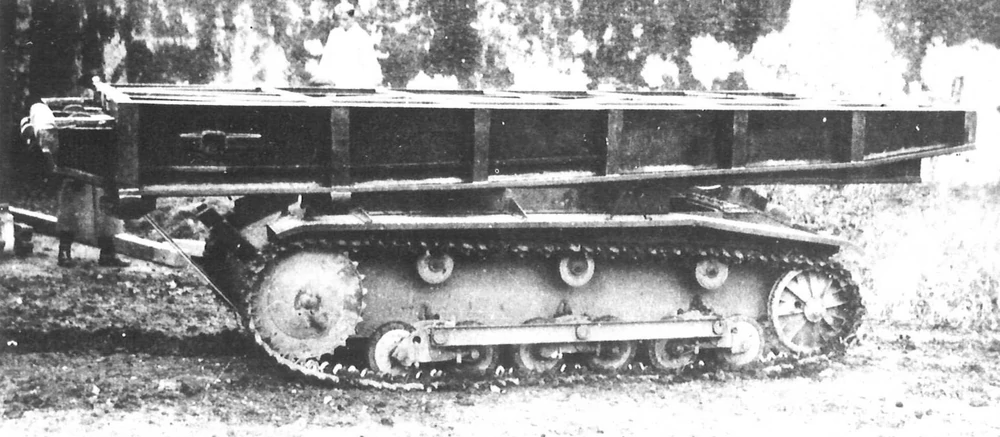
We previously mentioned how the OBA, DC’s, and DB might Rubble the whole building to gain victory so we will not cover that here. The flamethrowers will definitely be there in the endgame, attacking the Q4 Building with 24 flat shots. Destruction of these has to be a priority.
Finally, every German AFV has an sD 6 which can provide cover for the final assault. In addition, the PzIVCs have a printed Smoke Depletion number of 9, becoming a 10 since the German AFVs are Elite for Special Ammunition. The Poles must expect the Germans to marshal this Smoke ability into the endgame. If presented with a reasonable chance to eliminate a PzIVC, the Poles should take that chance. Also keep in mind the AFVs can create breaches into the Ground level of Q4.
Making A Plan
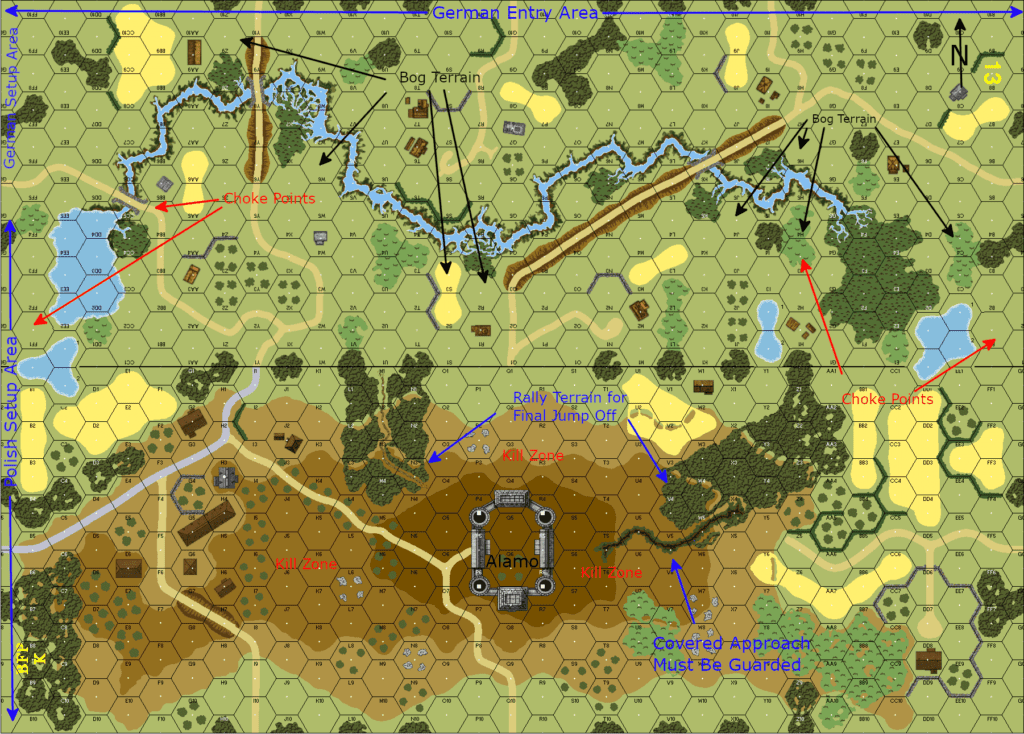
The image above provides a detailed analysis of the terrain. I have identified the Alamo. Probable “jump-off” points for the final assault are noted as is a concerning covered approach. The mandatory Cupola in R6 sees right into the Gully providing some fire, but having another option would be helpful. Recall, the PzIV’s are likely to be here as Smoke machines in the endgame so expect at least a +4 DRM shooting out of Smoke.
Also identified are several possible “Kill Zones.” In case it is not clear, the whole area around the Q4 building is a “Kill Zone” and the Germans must pay dearly for this ground.
The path in the M3/N3 Woods hex is a good candidate for Wire if there is some to spare. Remember, the Polish goal is to run out the clock and spending 4 MFs to cross to higher terrain will make this approach very difficult.
With that in mind, let’s see what we come up with.
Proposed Polish Setup
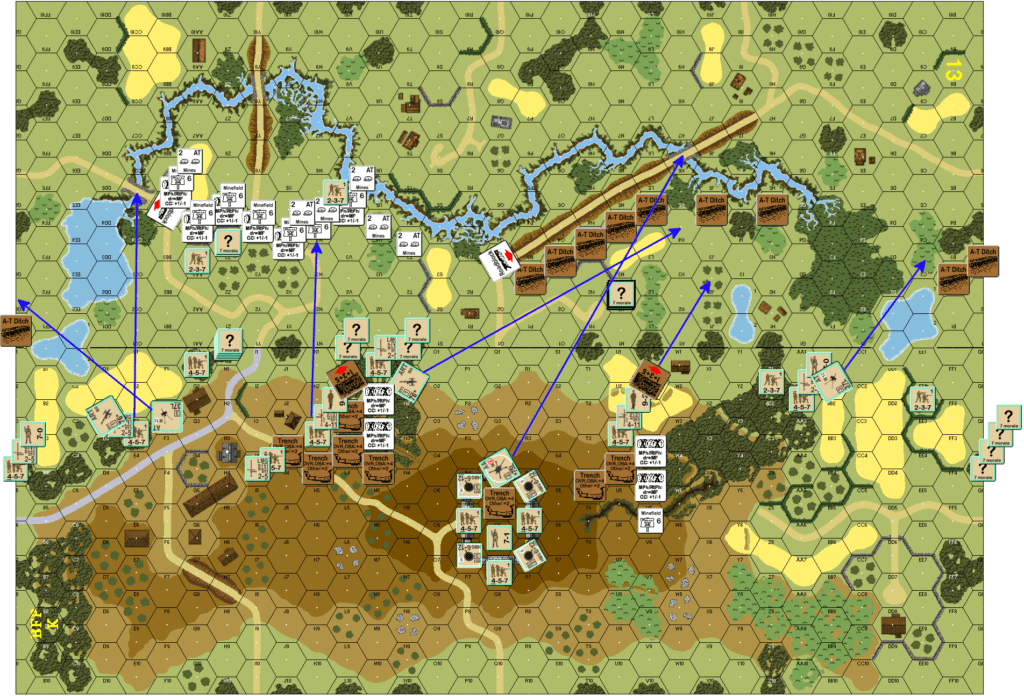
The image above is my proposed Polish setup. Each of the blue arrows represents a bore-sighted Location for either a Gun or the MMG’s. Crews possess each of the Guns not shown here and they all begin the game Hidden (HIP). All the Fortifications begin the game Hidden and revealed only when a Good Order German unit gains LOS to them. Each depicted half squad begins the game Hidden. The 7-0/4-5-7/LMG combo in BFP-K A4 also begins Hidden.
Primary Focus
The primary focus of this defense is to run out the clock on the German player. To achieve this, I am using a combination of Defense In Depth, Fighting Withdrawal, Area Defense, and Alamo defensive patterns. Choke Points are also being used to attack German mobility. Unfortunately, there is not a lot of good ground for Strong Points which usually make up a good defense, but placement of Trenches and Pillboxes can help to create artificial Strong Points.
The initial focus of this defense is to defend the area around 13Y6. Wire and Mines are there to blunt any German advance beginning on the Polish side of the stream. The 4-5-7/LMG in KM1 is a compromise to safety which can still support the Y6 area. When it leaves to reinforce the Alamo, the Wire along the trail will probably still be Hidden and the retreating Poles will not have to roll to get below the Wire. The same thing applies to the 9-1/4-5-7/MMG combo in the Pillbox in KK3 will also take advantage of this when it opts to retreat.
The secondary focus of this defense is to destroy the PzII Bridgelayers. The 37L’s are in position to shoot likely attempts at a breach and have Bore-sighted the Locations the bridges might be placed from. PzII Bridgelayers cannot place bridges from within a Stream hex across an A-T Ditch. The Bridgelayers can place bridges from the Elevated Road across the A-T Ditch. The 75L AA Gun is there to protect against that (the entirety of the Q4 building is Fortified by SSR).
Fallback Plan
During play, the units on the wings will move towards the Q4 building on turn 1. It will take them the longest to get to the Q4 building. Everything capable of reaching the Q4 building will be stuffed into that building not later than the start of German 5. This will give the Germans only 4 turns to close on the top of the hill, cross the open ground, and capture all 24 Locations.
Endgame Plan
The Trench in the center of the Q4 building will be the permanent home for the 9-2 and serve as the Rally factory for the Alamo. As long as units can rout to the “other” side of the Q4 Building, Low Crawl to the Trench is an option. Trenches are Rally terrain meaning DM units will only add a +1 DRM to Rally attempts in the center. This should allow for units to be quickly pushed back into the line if needed.
Potential Improvements
There is a gap in this defense if the Germans push all of their AFVs through Y6. As presented here, the only real reaction to this is pushing the Gun in KF2 to G3/G4. The 76 Art Gun in KE3 helps to cover the Elevated Road, but this is a lot to ask from this Gun. Moving one of the 37L AT Guns to cover here is not an unreasonable decision, but doing so creates a gap somewhere else.
A better solution to cover this threat would be to reposition the 76 Art in N1 and the 75L AA gun to cover the Y6 area. Moving the AA gun opens up the possibility of placing a Bridge from the Elevated road with no chance of stopping it, allowing the Germans to rush headlong right into the center of our defense. One of the 37Ls should be moved to cover this (from the Polish right is likely best).
The Pillbox in KU3 might be better pointing its Covered Arc toward KT1. Doing so allows the 9-2/4-5-7/MMG to cover the Y6 area. This would probably be even better than what I have depicted here.
As you can see, you can’t defend everywhere. All defenses are a series of tradeoffs. The key is enough flexibility to react without exposing too many of your units to fire. Still, my biggest fear as the Defender is a push through the A6 area.
Conclusion

I have never played this game so I do not have practical experience to pass along on how this works. Given the German OB, I suspect the Polish player’s Personal Morale will be put to the test. ROAR has this as 7 wins for the Poles against 8 wins for the Germans. Game reporting on the ASL Scenario Archive paints a much grimmer picture for the Poles.
There is no doubt in my mind this will be a brutal exchange between these two OBs. The Poles will place maximum pain on the Germans early. If the Germans identify a gap in the defense and exploit it early, this spells trouble for the Poles. German firepower at close ranges coupled with 150mm OBA is more than enough to pound the Q4 building into submission. As long as there is one building Location the Germans can not get to, the Poles have a chance but hanging in that game in the face of all that concentrated firepower is a tough ask.
I hope you found this article enjoyable. If you would like to see more like this, nominate other scenarios in the comments below. Until next time. – jim


Hi Jim, I would like you to analyze how the German should defend in FT318(the scenario is in From the Cellar#12), I think the German do have excellent troops but too few (even counting reinforcements) to defend a so wide map, and the Soviets have plenty of tanks and infantry, I would like to know how to plan a defense as the German.
I will take a look and see what I can do. I will be traveling a lot in the near term so please be patient.
How does the AA Gun get to set up in the building?
The castle is Fortified by SSR.
Nope, you aren’t missing anything. I made a mistake placing them. I would still place them where they are as one factor, removing the one in the road. Thanks for catching this. — jim